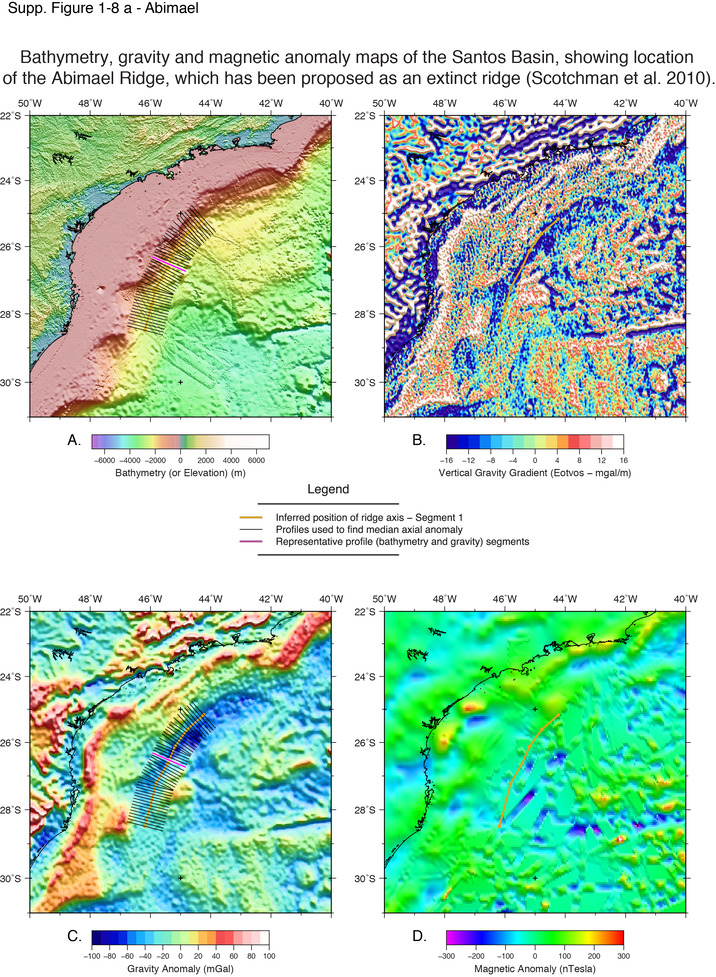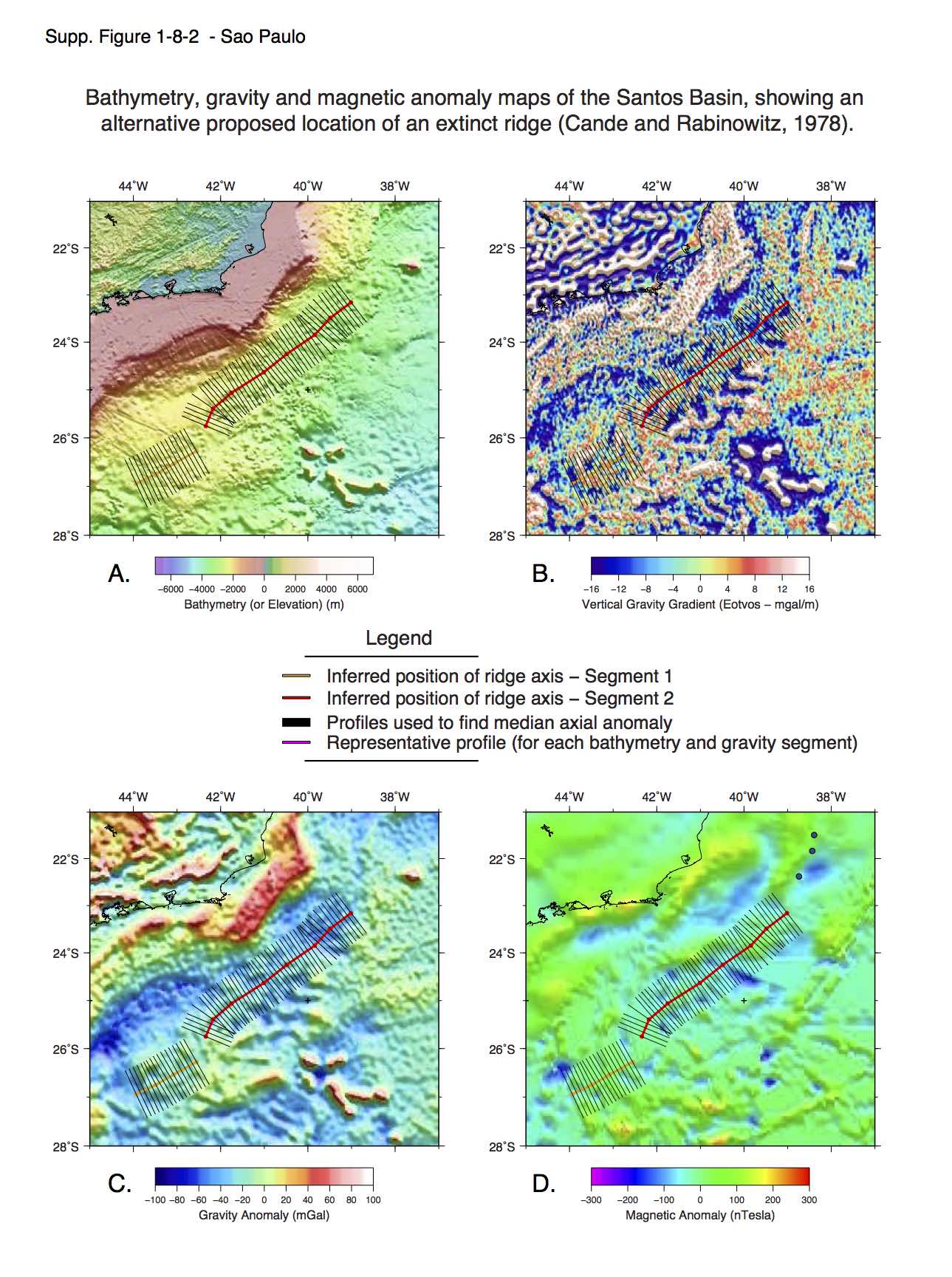| Ocean: | Atlantic |
| Spreading center type: | Large-scale MOR |
| Time of cessation: | Ca. 110 Ma, Chron C34 (Scotchman et al., 2010) |
| Subsequent active spreading center: | Present-day Mid-Atlantic Ridge |
Two different locations have been proposed as extinct ridges within the region of the Santos Basin offshore eastern Brazil and we will discuss these alternatives in turn. Cande and Rabinowitz (1978) proposed that there was a 200 km eastward migration of the spreading ridge between Brazil and the Angolan margin during early South Atlantic opening, in the late Aptian (112 - 125 Ma). They reported that symmetric magnetic anomalies could be identified within the Sao Paulo Plateau, which they took to confirm the presence of an extinct ridge axis in this location, representing either anomaly M3 or M0 (Cande and Rabinowitz, 1978). Slow spreading within the basin was attributed to the proximity of the pole of rotation during the early opening of the South Atlantic (Cande and Rabinowitz 1978). Since the work of Cande and Rabinowitz (1978), and in contradiction to their findings, there has been some evidence that the Sao Paulo Plateau is composed of thinned continental crust (Chang et al. 1992). Although deep-sea drilling in the area has not reached basement and therefore has not confirmed, recently Klinghoefer et al. (2015) concluded from seismic profiles and tomography that the Plateau is indeed composed of continental crust.
Other recent studies have proposed an extinct spreading centre in close proximity to the South American continent-ocean boundary, situated in the Santos Basin (Scotchman et al. 2010; Mohriak, 2001 ). The inferred spreading centre is thought to be situated at an observed linear gravity-low, ~475 km in length, that is approximately parallel to the Brazilian coastline. The key work reporting this feature, Scotchman et al. (2010), unfortunately provides no geographic information on figures that show the possible ridge axis. However, the seismic sections that are displayed indicate that the gravity low has a width of ~130 km, which is 2-3 times that reported at well-defined extinct ridges, and may therefore hint at an alternative explanation for the observed gravity low. Klingelhoefer et al. (2015) report a zone of serpentinization down to several kilometres depth in the region of Scotchman et al.'s (2010) proposed extinct ridge.
An alternative location to that of Scotchman et al. (2010) is suggested by Meisling et al. 2001, who interpret the ridge axis as a linear positive gravity anomaly closer to the Brazilian coastline. Stica et al. (2014) consider the low-gravity structure to represent a failed slow spreading rift, represented by exhumed mantle rather than volcanic rocks. This could explain the presence of the zone of serpentinization at the perimeter of the Sao Paulo Rise and Plateau (Klingelhoefer et al., 2015), which may have formed by very slow spreading, such as that seen on the present-day Southwest Indian Ridge (Sauter et al., 2013).
Contreras et al. (2010) investigated seismic profiles across the nearby Campos Basin and interpreted a Barremian basement high that could potentially represent an extinct axis. Whilst they report that thinned continental crust underlies the Campos and Santos basins their stratigraphic columns show basalt as the basal unit of the logs, with at least several hundred metres thickness and no basal depth indicated. The basement high is much less clear on the Santos Basin profile, compared with the more northerly Campos Basin (ibid). Geraldes et al. (2013) support the Scotchman et al. (2010) hypothesized extinct ridge, but in these works are there clear basement expressions or magnetic anomalies that could conclusively prove the presence of an extinct ridge.
A recent suggestion was made that the Abimael Ridge may have been propagating northward, but failed due to encoutering a barrier there (Mohriak, 2016 abs.).
We have tested extinct ridge placements proposed by Cande and Rabinowitz (1978) and Scotchman et al. (2010) in the Santos Basin and found that both the bathymetry and gravity signals are weak and inconclusive. Bathymetrically, the ridge is a non-descript feature situated at depth ranging between 2000 - 3000m, without a clear axial trace. Whilst the feature is associated with a gravity anomaly, the form of the anomaly is dissimilar to the characteristic signature seen at other extinct ridges or transform faults.
Cande, S. C. and Rabinowitz, P.D., 1978. Mesozoic seafloor spreading bordering conjugate continental margins of Angola and Brazil. In Offshore Technology Conference. pp. 1–8.
Chang, H. K., Kowsmann, R. O., Figueiredo, A. M. F., and Bender A. A. 1992. Tectonics and stratigraphy of the East Brazil Rift system: an overview. Tectonophysics, 213, 97-138.
Contreras, J., Zühike, R., Bowman, S. and Bechstädt 2010. Seismic stratigraphy and subsidence analysis of the southern Brazilian margin (Campos, Santos and Pelotas basins). Marine and Petroleum Geology, 27(9), pp.1952–1980.
Geraldes, M. C., Motoki, A., Costa, A., Mota, C. E. and Mohriak, W. U. 2013. Geochronology (Ar/Ar and K – Ar) of the South Atlantic post-break-up magmatism. In W. U. Mohriak et al., eds. Conjugate Divergent Margins. Geological Society of London, pp. 41–74.
Klingelhoefer, F., Evain, M., Rigoti, C., Loureiro, A., Alves, D., Leprêtre, A., Moulin, M., Schnurle, P., Benabdellouahed, M., Baltzer, A., Rabineau, M., Feld, A., Viana, A. and Aslanian, D., 2015. Imaging proto-oceanic crust off the Brazilian Continental Margin. Geophysical Journal International, 200, pp.471–488.
Meisling, K.E., Cobbold, P.R. and Mount, V.S., 2001. Segmentation of an obliquely rifted margin, Campos and Santos basins, southeastern Brazil. AAPG Bulletin, 85(11), pp.1903–1924.
Mohriak, W.U., 2001. Salt tectonics, volcanic centers, fracture zones and their relationship with the origin and evolution of the South Atlantic Ocean: geophysical evidence in the Brazilian and West African margins. 7th International Congress of the Brazilian Geophysical Society, Salvador, Brazil, October 28–31, Expanded Abstract, p. 1594.
Mohriak, W. 2016. Rifting and salt deposition in passive continental margin basins: differences and similarities between the Red Sea and the South Atlantic - abstract. Passive Margins, Royal Holloway University of London, 6-8 April 2016.
Sauter, D., Cannat, M., Rouméjon, S., Andreani, M., Birot, D., Bronner, A., Brunelli, D., Carlut, J., Delacour, A., Guyader, V. and MacLeod, C.J., 2013. Continuous exhumation of mantle-derived rocks at the Southwest Indian Ridge for 11 million years. Nature Geoscience, 6(4), pp.314-320.
Scotchman, I. C., Gilchrist, G., Kusznir, N. J., Roberts, A. M., and Fletcher, R., 2010. The breakup of the South Atlantic Ocean : formation of failed spreading axes and blocks of thinned continental crust in the Santos Basin, Brazil and its consequences for petroleum system development. In Petroleum Geology Conference series, Vol. 7. pp. 855–866.





